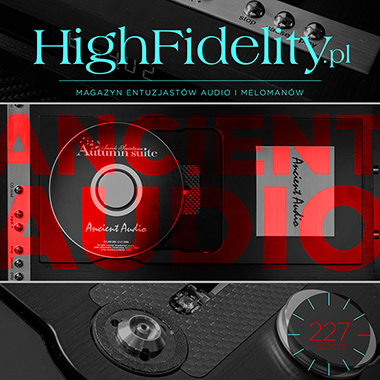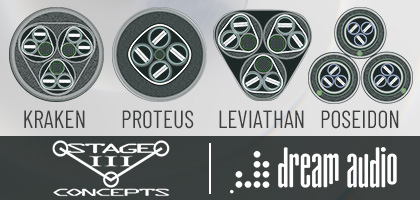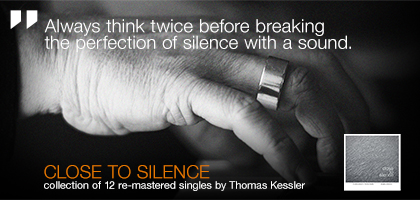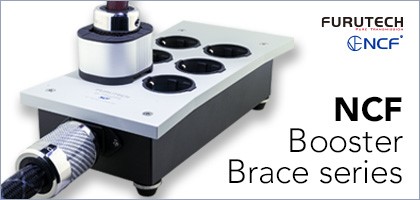No. 259 December 2025
- COVER REVIEW: LUMEN WHITE Altai ⸜ loudspeakers » AUSTRIA
- COVERAGE ⸜ audio show: HIGH FIDELITY on Audio Video Show 2025. A few worlds about time… » POLAND
- REVIEW: ACOUSTIC REVIVE Absolute Power Cord-K ⸜ power cable AC » JAPAN
- REVIEW: ANCIENT AUDIO Lektor 30th Anniversary ⸜ CD player » POLAND
- REVIEW: HAIKU-AUDIO Sol2 Pro ⸜ integrated amplifier » POLAND
- REVIEW: NORSE AUDIO X1 & X5 ⸜ power amplifier • stereo & power supply DC » SWEDEN
- REVIEW: SME Model 35 + Model Vi ⸜ turntable + tonearm » GREAT BRITAIN
- REVIEW: TiGLON MZ-Grande ⸜ anti-vibration feet » JAPAN
- REVIEW: THUNDER MELODY Ground Hub Black Edition ⸜ anti-vibration platform & ground unit » POLAND
- REVIEW: WK AUDIO TheRay Basic ⸜ analogue interconnect RCA » POLAND

|
Editorial
text WOJCIECH PACUŁA |
 |
No 227 April 1, 2023 |
|
AUDIOPHILE WHITEWASHING
Because people want others to see them as good. We want to believe that good wins. And goodness is associated with brightness, purity, white color. On the other hand, evil often seen associated with dark colors, especially black. Just look at the iconography depicting biblical events - heaven, angels are white, gold, silver, while Satan is the "lord of darkness", "black". Anyway, the root of the Polish word for 'underwear' (bielizna) is clear in this context - 'underwear' is a piece of white clothing. The whiter it is, the better. 
⸜ The first case when Mobile Fidelity released a disc in the "Original Master Recordings" series, i.e. one supposed to come from the "master" tape, and when it reached not only for a new master, but a completely new, digital remaster. Greenwashing combines the desire to whitewashing with its object - ecology. It is enough for a corporation that sells hundreds of thousands of tons of meat, which is the source of 40% of the methane released into the atmosphere, to put wastebaskets in its restaurants to segregate waste from dishes, cups, etc., so that it can call itself "green" or „eco-friendly”. And this is just one of many, many instances of such fraud. Because it's a scam, there's no need to beat around the bush. The audio world also has, is and will witness attempts to whitewash itself. For various reasons. Whether it's by releasing a defective product, or by not caring for the customers after the purchase, or by misleading them as to the properties of the product they bought. We dealt with the latter in the case of Mobile Fidelity Audio Labs. Do you remember what happened last year? If not, let me briefly remind you that it was about the label misleading its customers. The point was that in the company materials and in the description of the releases, they suggested that the varnish from which the matrices for LP pressing were made was cut directly from analog master tapes, after passing through a self-developed remastering system; this technology was called GAIN 2 Ultra Analog, and it was developed by Tim De Paravicini, in consultation with Stan Ricker (more → HERE, accessed: 02/23/2023. In fact, as established by the video blogger MIKE ESPOSITO, for many years MoFi - as its name is shortened - copied analog tapes to the computer, in the form of DSD files, and only then remastered them in analog domain. They justified it saying that it gave them the possibility to precisely set the bevel of the head for each track. Let us remind you that the original "master" tapes are glued together from session tapes, and it is true that each of the tracks could have been created at a different time and on a different tape recorder. Thanks to this procedure, it was also possible to make an infinite number of matrices, without involving the original tapes. 
⸜ John Lennon's album came out with inserts that read: "Ultradics II discs are mastered in the Gain 2 system developed by us directly from the original mastering tapes." It all came out on the occasion of the MICHAEL JACKSON's "Thriller" album remaster, pressed in the "one-step" process. It has a "limited" number of 40,000 copies, and with this technique it is necessary to change the matrix every 1000 pieces. Reproducing the signal from the analog "master" tape, MoFi would have to play it forty times (more → HERE). By the way, other "understatements" came to light. Like DONALD FAGEN's The Nightfly and Brothers in Arms by DIRE STRAITS. The first one was recorded on a 3M reel-to-reel digital tape recorder with a signal of 16 bits and 48 kHz. And yet it was labeled "Original Master Recording", suggesting the use of an analog "master" tape. Not only was the MoFi remaster not made of analog tape, it also used PCM digital tape. There is nothing wrong with that, this is how a lot of great-sounding LPs were created in the years 1971-1991. I am a fan of many of these solutions and Mobile Fidelity did an excellent job. It's just that they covered it up. There is another problem with the Straits album. This album was recorded on two Sony DASH 24-track reel-to-reel digital tape recorders, with values of 16 bits, 48 kHz. However, the mix was already done on an analog console and the stereo master tape was analog (1/2"; more → HERE). For some reason it wasn't used in the MoFi remastering. The signal was taken from a U-matic digital mastering tape, made for the CD and LP versions in 1984, when the album was first released. I have no problem with that, the record sounds great, but again - I was misled. 
⸜ This album started the whole affair and forced Mobile Fidelity into explaining of their remastering methods; the photo shows the SACD version, where there is no mention of it. I found out about all this only after the scandal spilled out in the audio community. In a statement issued at that time, JIM DAVIS, the owner of the Music Direct audio store chain, which also owns the Mobile Fidelity record label, suggested that there was a misunderstanding and announced that from now on all reissues will be described correctly (more → HERE, accessed on February 23rd 2023; interestingly, this statement disappeared from the website after some time). |
And indeed, on the stickers, on the website and in the LP inserts there was a description of the currently used remastering process, confirming the use of DSD files, i.e. talking about the transition from the analog to the digital domain and back. It seems to me that at the same time a campaign was launched to improve the company's image. Davis in his statement didn't apologize for years of misrepresentation, no such statement was made anywhere. As I say, the suggestion went in the direction of "understatement". At the same time, articles relativizing this situation appeared in many trade magazines. I do not think that they took part in the paid-for set-up, but rather that they played the role of "useful idiots". In a word, the whitewashing of the Mobile Fidelity brand has started in full swing. In fact, I understood it. I didn't like the way the conflict was resolved (although there is still a long way to go, there are several lawsuits against the owner of the record label in American courts), but - I understood. The more so that I took at face value the announcement of full transparency of the remastering process that we were promised. I figured it was better than nothing. Something struck me though, when I was preparing for the first meeting of the Tour de Pologne series, during which I ran workshops entitled Digital Recordings 1971-2023 on LPs (more → HERE). To check what Mobile revealed about the Brothers in Arms, I went to the dedicated tab and was surprised to read about the already mentioned U-matic master. 
⸜ In the insert with which the Thriller album comes in the SACD version, it still says: "(...) their [Mobile Fidelity label - ed.] digital projects are mastered directly from the original mastering tapes". Not a word about the earlier switch to DSD and mastering from files. So it seems it wasn't about setting the skew of the tape, because there is no mention of analog tape and DSD, right? They were simply afraid to tell audiophiles that not only they prepared a multi-track master was digital, but also the mastering process had little to do with analog. And now, when we know what version was used for this remaster, even now we are "spared" the knowledge that it was a 16-bit, 44.1kHz PCM signal. Who will bother to check what this U-matic is, right? All the more nobody will delve into the mysterious phrase "digital clone". Because MoFi made the remaster not from a digital master, but from its digital copy. But what kind, who made it and whether it was a copy saved in a DAW (computer file) or on a hardware device - we still don’t know. We will encounter similar difficulties trying to find out the truth about MARK KNOPFLER's Local Hero. Recorded in 1983, it sounds exceptionally good, despite the fact that for years the U-matic master was used for subsequent reissues. However, when MILES SHOWELL, a recording engineer at Abbey Road, was preparing a new "half-speed" remaster, research showed that this album was recorded on a 3M reel-to-reel digital tape recorder. In addition, the stereo master was recorded on the same 32-track tape as the individual tracks. This is a machine working with a sampling frequency of 48 kHz and a 16-bit word length (more → HERE https://superdeluxedition.com/interview/dire-straits-and-mark-knopfler-half-speed-mastering-details-revealed, accessed: February 23, 2023). The same story repeats as with the Knopfler’s band - MoFi informs us that the signal comes from a "digital clone" of the "master" tape and that it was a 3M tape. However, it does not say that it is a remaster from files saved by one of the external companies offering archiving services. We also don't know whether the signal was upsampled or not, and above all that it was a PCM signal of 16 bits and 50 kHz. It is not known whether this unusual sampling frequency forced the conversion to the one adopted in modern systems and saving the signal in the form of files, or whether the tape was played in the MoFi studio from a 3M tape recorder. I'd bet on the first. There is nothing wrong with digital recordings. As I've tried to show in a series of articles on digital recorders, a well-done digital recording can sound spectacularly good. Especially when we think about early tape recorders of this type. The U-matic is not the best mastering tape recorder, mainly due to the not-so-precise digital filters, but I know many recordings made using it that are phenomenally good. Apparently, a copy of the Dire Straits album also belongs to this group. Also, switching from 50kHz to any other sampling frequency means losses. 
⸜ The Dire Straits Brothers In Arms is an interesting example of untruth - it was remastered from a copy (files) of the U-matic digital tape, so there was no need to "match the head bevels" of the analog tape. Whether it was so - we do not know. MoFi has decided not to explain it too much. PCM? 16 bits? 48 or 50kHz? – After all, it is the antithesis of what this company has been promoting for many, many years. "Only analog", "analog is the best and digital is the worse". – This is the story, to paraphrase, they have been telling us for years, training successive generations of audiophiles in stupidity. Now it turned against them. Not because there is anything wrong with digital, but because the company said one thing and did another. If you look at all this from the right angle, you could wave your hand and enjoy the really great reissues of this label. If it weren't for a small, seemingly insignificant fact: it turned out that Jim Davis' promises of full transparency do not apply to SACDs at all. Please look at the description of any title, older or newer, and we will not find a word about the origin of the material used for the remaster, nor a description of its course. And yet on the covers of these albums there is the same slogan as on the vinyl releases, referring to the analog master as the source of the signal. Damn it - don't owners of CD and SACD players deserve to be taken seriously? Or is this just another part of the whitewashing campaign? I read it this way, that because the allegations were about the incorrect description of analog discs, with their digital releases you can skip the explanations, pretending that everything is fine. But it is not. The question is, whether this whitewashing or audiophilewashing campaign, will really be good for the label? I have a feeling that the more their owner goes into corporate problem-solving mode, the worse it is for them. After all, audio is a small world. In addition, one in which we invested a lot of our emotions, money and hope for a good sound. Once broken trust will be very difficult to regain. And certainly not with these methods. ● WOJCIECH PACUŁA |
About Us |
We cooperate |
Patrons |
|
Our reviewers regularly contribute to “Enjoy the Music.com”, “Positive-Feedback.com”, “HiFiStatement.net” and “Hi-Fi Choice & Home Cinema. Edycja Polska” . "High Fidelity" is a monthly magazine dedicated to high quality sound. It has been published since May 1st, 2004. Up until October 2008, the magazine was called "High Fidelity OnLine", but since November 2008 it has been registered under the new title. "High Fidelity" is an online magazine, i.e. it is only published on the web. For the last few years it has been published both in Polish and in English. Thanks to our English section, the magazine has now a worldwide reach - statistics show that we have readers from almost every country in the world. Once a year, we prepare a printed edition of one of reviews published online. This unique, limited collector's edition is given to the visitors of the Audio Show in Warsaw, Poland, held in November of each year. For years, "High Fidelity" has been cooperating with other audio magazines, including “Enjoy the Music.com” and “Positive-Feedback.com” in the U.S. and “HiFiStatement.net” in Germany. Our reviews have also been published by “6moons.com”. You can contact any of our contributors by clicking his email address on our CONTACT page. |
 



|
   |
main page | archive | contact | kts
© 2009 HighFidelity, design by PikselStudio,
projektowanie stron www: Indecity







 HE CONCEPT OF GREENWASHING has entered general circulation for good. There is no good equivalent in Polish, although the closest to it would be the "whitening”. However, using it we do not indicate what is actually whitewashed, but only a general desire to show our better side.
HE CONCEPT OF GREENWASHING has entered general circulation for good. There is no good equivalent in Polish, although the closest to it would be the "whitening”. However, using it we do not indicate what is actually whitewashed, but only a general desire to show our better side.


